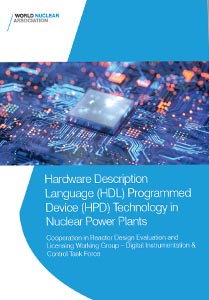Hardware Description Language (HDL) Programmed Device (HPD) Technology in Nuclear Power Plants
Cooperation in Reactor Design Evaluation and Licensing Working Group – Digital Instrumentation & Control Task Force
First published May 2022
Hardware description language (HDL) programmed devices (HPDs), such as field programmable gate arrays (FPGAs), used in nuclear power plant instrumentation and control (I&C) systems, offer several benefits over standard microprocessor-based I&C systems. Their capability to perform a wide range of independent functions with a high clock speed makes them well-suited to applications requiring very short response times. Furthermore, HPD’s provide ‘by design’ separation of ancillary functions from the main safety I&C functions, therefore a postulated failure of an ancillary function will not prevent the correct execution of the safety I&C functions.
As a result, nuclear industry interest in the use of HPD-based technology has been increasing. However, despite early efforts to achieve harmonization in the requirements for HPD-based I&C platforms, efforts at harmonization have stalled. There are differences between national regulatory approaches to the treatment of HPDs, particularly in relation to the need for statistical testing and in the treatment of common cause failure (CCF) vulnerabilities. This divergence of regulatory approach is exacerbated by the lack of harmonization in nuclear industry standards. In particular, the International Electrotechnical Commission (IEC) has some standards that do not cover the full range of possible uses (i.e. in systems performing Category B&C safety functions), while the Institute of Electrical and Electronics Engineers (IEEE) has no corresponding standards for HPD development and use.
This report identifies the lack of consistent approach in industry standards and differences in regulatory approach relating to the use of HPD technology in nuclear power plants. The potential impacts on the future use of HPD technology are assessed and recommendations to achieve greater harmonization are provided.
To develop a consistent approach within industry standards the key recommendations from the Cooperation in Reactor Design Evaluation and Licensing (CORDEL) Working Group of World Nuclear Association are:
- The IEEE should address the lack of standards for the development of HPD technology in the nuclear sector through development and alignment of its own standards to those already existing or joint standard adoption of applicable IEC standards.
- The IEC standards that address the treatment of CCF in systems performing Category A functions should be updated to incorporate the various capabilities of HPD technology to address CCF vulnerabilities through internal diversity.
- A new standard should be considered for electrical systems to address the use of digital devices and data networks.
The development of consistent industry standards will support a common approach to the use of HPDs within the design of I&C systems. However, to support a consistent treatment of these devices by national regulators, CORDEL recommends:
- The Nuclear Energy Agency (NEA) Committee on Nuclear Regulatory Activities (CNRA) should consider updating its current position to include systems and components that perform Category B&C functions.
- National regulators should continue with efforts to address the commercial-grade dedication of commercial off-the-shelf digital equipment using third-party certification.
